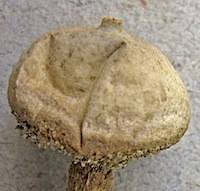
|
|
|
|
Family: Agaricaceae
|
Wright J.E. 1987. Bibliotheca Mycologia 113: 104. Tulostoma ferrugineum Oliver and Hosford. - Mycotaxon 9: 279-280, figs. 2-3. 1979. Etym.: the name refers to the colour of the spore-sac. Spore-sac subglobose to globose-depressed, 7.5-10 x 10-13 mm. Exoperidium hyphal, with threads agglutinated with sand particles, not persistent. Endoperidium membranous, tough, greyish brown, finally smooth. Mouth tubular, short, projecting abt 1 mm and 1 mm in diam, peristome 1-1.5 mm wide, bleaching with age. Socket indistinct. Gleba not described. Stem 22-55 x 3-4 mm, straight to slightly tapering towards the base, reddish brown, distinctly squamulose, with a bulbous base formed by sand, hyphae and rootlets. Spores 5-6-(7) µm diam, averaging 5.5 µm diam, globose to subglobose, markedly verrucose, the verrucae truncate, extending within an amorphous hyaline layer; in optical section a partial reticulum may be observed when mounted in 3.% KOH, acyanophilous in cotton-blue, inamyloid. Capillitium hyaline, threads 4-9 µm diam, smooth walled, thick-walled, without crystalline deposits, frequently branched and septate, swollen at the yellowish septa up to 6-12 µm diam. (Description rearranged from the original diagnosis). Habitat: solitary or gregarious in semistabilized dunicolous areas, in protected sites, associated with Chrysothamnus spp. amd other shrubs; end of winter and spring. Distribution: NE (NW editorial correction) United States. Holotype: United States, Washington, Franklin Co., Juniper Forest N of Pasco, leg. Oliver 145 (WSU?). Not seen. Illustration: Oliver & Hosford (op.cit.). |













